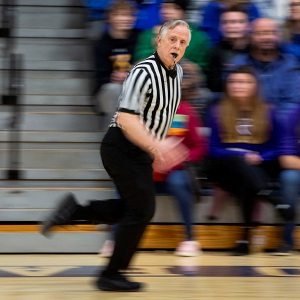Leveling a legacy: 75-year-old ski jump demolished at Storrs Hill in Lebanon
| Published: 10-22-2022 10:10 PM |
LEBANON — At 8:21 a.m., a crack like rifle fire shot through the cold autumn air, and with one short tug from an 85-horsepower John Deere skidder, the ski jump structure at Storrs Hill Ski Area collapsed into a heap of splintered wood.
“I was here at its beginning, and I am here at its end,” reflected Erling H. Heistad, who as a 7-year-old boy helped his father, the late famed Lebanon ski coach and ski jump designer Erling Heistad, build the 25-meter ski jump during the summer of 1947.
“I carried up planks one at a time,” the younger Heistad remembered.
Now, 75 years later, he stood on the frosty ground to watch once of his family’s legacies knocked down like a stack of toothpicks.
“You’ve bookended it,” Heistad’s daughter, Kari Heistad, said proudly, standing with her father and his wife, Kim Rheinlander, on the slope of Storrs Hill. They were a few dozen feet from the debris that minutes earlier had been a testament to the Heistad family’s dedication in making Lebanon a center for training Olympian ski jumpers for generations.
“Nobody expected the jump to last this long,” Heistad said.
On Saturday, work crews from Lebanon excavator D.R. Key Corp., stump grinder and bushhogger Spencer Powers Services of Canaan and Plainfield’s Robbie Williams Excavating, along with members of the Lebanon Outing Club, gathered at 7 a.m. to begin work on razing the three-quarter-century-old ski jump, which was found to be unsound after this past ski season when a cross-brace broke off and visible rotting appeared on the old telephone poles holding up the ski deck.
The ski jump “lost some of its structural support over the summer, so we are forced to take it take it down. The cost to fix and rebuild it is just too high right now,” said Cory Grant, president of the Lebanon Outing Club, as he oversaw the morning’s demolition.
Article continues after...
Yesterday's Most Read Articles
The jump was the one used for the annual end-of-the-season “Ring of Fire” competition in which a large rebar hoop is wrapped in rags, doused with diesel kerosene and set ablaze for daring skiers to jump through.
Volunteers prepped the razing by hooking a strap around the poles near the top and slicing the ski deck in half with power chainsaws to make it easier to break apart. Two ends of the strap then met and were attached to a chain that itself was hooked onto the skidder.
The operator thrust the skidder into reverse, the line to the poles stretched taut, and seconds later the entire structure ripped apart.
“Came down pretty quickly,” Grant said with satisfaction.
The 25-meter ski jump (the length refers to the edge of the jump platform to the point where the hill begins to flatten; it does not refer to the length of jump platform) is considered to be the intermediate-level jump at Storrs Hill, which has a beginner 15-meter land jump and an advanced 50-meter platform jump named Heistad Hill after the elder Erling Heistad, who died in 1967.
“It’s the workhouse of the whole deal, a stepping stone that allows you to go off Heistad Hill,” said Heistad, who last jumped off the 25-meter jump seven years ago at age 75. He noted the intermediate-level jump was used often by college and high school jumpers in the region — Heistad said he once counted skiers from 21 colleges and high schools show up on a single day.
Helena Mielcarz, 14, a Lebanon High School freshman and member of its ski jumping team, was walking away from the demolition with her father, Norris Cotton Cancer Center DartLab director Dan Mielcarz — who said he himself used to travel up from high school in Concord to ski the jump — toting away a splintered board from the demolished platform.
Mielcarz said she thought it “would be cool to have a piece” as a keepsake from the structure she has jumped off “hundreds” of times since she first took her first jump off in the fifth grade.
Hundreds? Really?
“Tuesday and Thursday, 10 times (per day), January through March,” Mielcarz calculated easily.
Kari Heistad also collected wood from the structure, which she plans to use to make Christmas ornaments and signs with an image of the ski jump burned into for family members.
“So everybody literally has a piece of history,” she explained.
Grant, of the outing club. said the telephone poles from the structure will be repurposed for trail markers along the club’s network of cross-country ski trails (the poles cannot be burned because they were soaked in toxic creosote). Disposable wood will be sorted and carted away.
Where the razed old ski jump stood, a new one will go up, according to Grant.
Not this year, however.
The club already has a design for a new 25-meter jump, but Grant said they face two hurdles in getting it built: money for the estimated $100,000 construction cost and a contractor able to take on the job.
“Everyone is booked up,” Grant explained, adding that the club has received some initial funding from the Jack and Dorthy Byrne Foundation and anticipates additional money from the federal Land Water Conservation Fund.
D.R. Key Corp. owner Andy Key brought his excavator to Storrs Hill, has been volunteering crews and equipment and has been moving around earth on the hill to build a new 15-meter beginner-level ski jump. He said he responded to a call from Upper Valley apartment building developer Mike Davidson seeking his assistance on both building and razing the hill’s ski jumps.
“We’ve been working nights, weekends,” said Key, who himself ski jumped at Storrs Hill when he was growing up in Lebanon,
“Everybody came together to make this happen,” Key said, before climbing into the cab of his excavator and piloting the arm and bucket of the mammoth machine to smash to pieces the remaining portion of the ski jump.
Contact John Lippman at jlippman@vnews.com.

 Woodstock boys lax defense steps up, holds off Hartford
Woodstock boys lax defense steps up, holds off Hartford Pick a sport and Pete DePalo’s has probably officiated it over the past 40-plus years
Pick a sport and Pete DePalo’s has probably officiated it over the past 40-plus years Lebanon girls lacrosse prevails over Coe-Brown
Lebanon girls lacrosse prevails over Coe-Brown Local roundup: Lebanon softball sweeps wins from Souhegan, Stark
Local roundup: Lebanon softball sweeps wins from Souhegan, Stark
